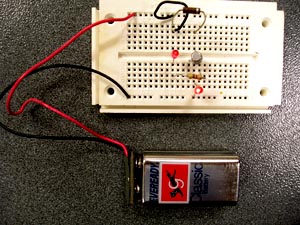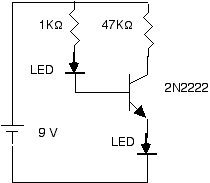Could you amplify that?

Light emitting diodes monitor the current flowing through a
transistor.
Could you amplify that?

Light emitting diodes monitor the current flowing through a
transistor.
Introduction
A normal, bipolar, transistor is a current controlled current source. You can use a small current flowing into a transistor to control a larger current flowing through the transistor.
Material
Assembly

LED's monitor the current flowing into the base of a transistor and out of the emitter.
Build the above circuit on the proto-board.

Notice that the transistor comes in a case, you must figure out which lead is which. If the transistor is a 2N2222 the emitter, E, is the lead closest to the tab on the metal can, the base, B, is the second closest lead to the tab. The emitter, E, is furthest from the tab. If you have a different transistor or a transistor with a plastic case search the web for the identification of the leads.
The LEDs have a longer lead and a shorter lead, the longer lead must go closer to the positive terminal of the battery. (If you install the LED backwards it will not light.)
To Do and Notice
Remove the 47 Kohm resistor and plug in the battery, notice that the LED does not come on.
Attach the 47 Kohm resistor and notice that the LED in series with the base of the transistor glows dimly while the transistor in series with the emitter glows brightly.
Replace the 47 Kohm resistor with a 10Kohm resistor and notice that the base LED is almost as bright as the emitter LED.
What's Going On?
The current flowing into the base of a transistor controls the current flowing through the collector and emitter.
In this circuit the current that flows through the collector to the emitter and on to the LED will be more than 40 times larger than the current that flows into the base.
The collector-emitter current is larger than the base-emitter current, the collector-emitter current is proportional to the base-emitter current.
The transistor is a current-controlled current-source. The current flowing into the base controls the current flowing out of the emitter.
The transistor can be used as a switch where small electric currents traveling over long wires can control large currents at a distance, It can also be used as an amplifier where small currents control large currents.
The light output of an LED is proportional to the electric current flowing through the LED. So you can see the electric current in the brightness of the LED.
If you replace the 47 Kohm resistor with the 10 Kohm resistor the gain of the transistor amplifier is 10 X and so the brightness of the output LED is only 10 X the brightness of the input LED.
Going Further
You can also remove the LED from the emitter and place it above the collector.
Etc.
When I refer to current I refer to "conventional current" the mythical flow of positive charges that produces the same effect as the actual flow of negative electrons through a wire.
|
Scientific Explorations with Paul Doherty |
|
18 November 2004 |